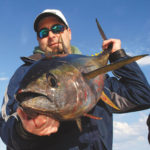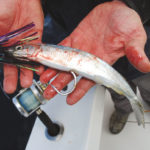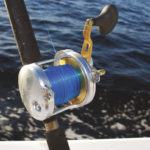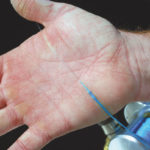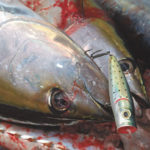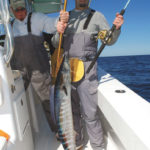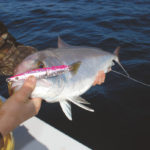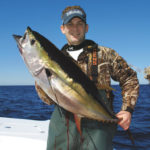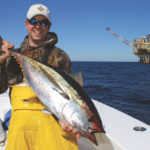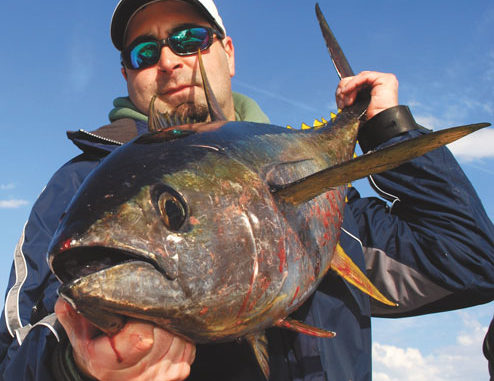
Now’s the time to get offshore and fill your fish box with tasty tuna and wonderful wahoo.
It was still dark as guide Kevin Beach’s big 33-foot catamaran zipped down Tiger Pass near Venice. Anthony Puglia had pulled his head down into his jacket like a turtle retracting its head into its shell.
“You’ve really got to love fishing to do this,” he said in muffled words. “Most people would think you are freakin’ crazy.”
It was cold, too cold for the time of the year. Ol’ Man Winter didn’t seem to want to relax his grip on Louisiana’s throat. But hunting season was over, and it was time to kick-off fishing season.
So Puglia explained to me when he called to invite me on the trip. He manages Puglia’s Sporting Goods, his father’s store on Veterans Highway in Metairie.
“Every year,” he explained, “we at Puglia’s like to take a fishing trip after hunting season. It’s a long, hard season, and it gives us a chance to wind down.
“Also this time of the year is when all the new fishing products come out, and a trip gives us a chance to test some of them.”
He explained that he was particularly interested in using the new Shimano Talica two-speed conventional reels. On board for the tuna and wahoo expedition would be model 16 II and 25 II reels.
PowerPro Hollow Ace lines, another new product, would be spooled on the reels. This spectra line is hollow, allowing for fluorocarbon or monofilament leaders or topshots to be inserted inside it and glued in place. Knotless, the two lines seam together, reducing friction and avoiding a lump in a spool of line.
Later, during the trip, Beach explained that the diameter of this 80-pound test line is equivalent to that of 16- to 20-pound-test mono, meaning that a smaller-spooled reel can be used to store adequate line for fishing.
“One perk of my job,” explained Puglia, “is getting to try new gear. I even get a chance to meet the people who design the equipment on a day-to-day basis, and occasionally I get to go fishing with them.
“I wake up every day happy. A lot of people are not fortunate enough to wake up looking forward to what they do. It’s basically Christmas every day. I am always opening boxes of stuff.
“But, it’s not like people think — that in this business you hunt and fish all the time. We have to work to get together for a trip. I have to turn down a lot of trips because I have to stay on top of my business. I want to see my customers taken care off.”
Puglia is tall and slender, and sports a knob of neatly trimmed black chin whiskers. His Sicilian heritage is evident in his dark eyes, olive complexion and dark hair. The fishing team he assembled for the trip included his cousin Phil Raspanti, Chip Trosclair, a regular store customer, and Justin Stokes, Puglia’s Gun Department Manager.
Raspanti is the youngest of the gang and like his cousin, dark-haired and dark-eyed. He is the quietest of the quartet. Trosclair carries a perpetual smirky grin, looking like nothing so much as the kid who got his hand into the cookie jar and didn’t get caught. Stokes, a Greenville, Miss., native, is strongly-built, with a face gilt with blonde, independently-mined whiskers. He offered up humorous country-boy observations about every event of the day. Oddly, the loquacious Stokes and shy Raspanti are best friends.
The boat was fast, almost too fast for such a cold morning. It slashed out of Tiger Pass into the Mississippi River, down the river through Pass a Loutre, then Southeast Pass and into the open Gulf of Mexico. In less than an hour, we were at our first destination, the 24-mile rigs. Only three oil platforms are left of the cluster of five after Hurricane Katrina toppled two of them. Two of the rigs are paired as twins and one is set separate.
Only then did I get a look at the captain of the Pale Horse. He’s a big dude at 6 foot, 2 inches and 250 pounds, and wears a flamboyantly red goatee. I later asked him how his chartering business came to be called the Mexican Gulf Fishing Company. I never did get an answer to that one, but he said that as many customers find him by looking up the unique name of the boat as they do searching for the company name.
He was a one-man beehive of activity while he was putting out his trolling lines. The rest of us could only watch, as it was clear that amateur fingers would only slow down his well-practiced routine.
Since the first target was to be wahoo, he rigged his lures with wire leaders. Wahoo, he explained, have sharp teeth, and can quickly cut fluorocarbon leaders. On the other hand, when he targets tuna, he uses fluorocarbon leaders because the fish “have really good eyesight.”
Beach set out four lines. Two were trolled from the boat’s outriggers and two were “flat lines,” trolled from rods stabbed in holders on the boat’s gunnels. One rod was rigged with a thawed ballyhoo directly behind an Ilander trolling lure. This one would run on the surface. Also rigged to run on the surface was a ballyhoo and Ilander rigged a few feet behind a Play Action Teaser Bird, which spluttered on the surface, hopefully grabbing a wahoo’s attention.
A third rod also held a ballyhoo and Ilander, but the bait was rigged behind a planer. The planer took the “hoo” down to about 50 feet below the surface. The last rod had no natural bait, but rather was rigged with what Beach called “a wiggle bait,” a Rapala X-Rap Magnum 30 diving lure. The lure was flashy. Originally a bonito color, Beach had dipped it in pink Dip-N-Glo.
Beach certainly gave the fish options.
Settled in with all four rods set, Beach set the big twin outboards to troll at 6.5 knots, and relaxed enough to talk about spring trolling out of Venice.
Wahoo, he explained, are relatively easy to find in the area of the 24-mile rigs until late April, then they taper off and the fishing will shift more to tuna. The change, he theorized, has more to do with the high Mississippi River levels than anything else.
“By then, this area will be chocolate,” he said. “Sometimes the water swirling behind a rig will bring clear water to the surface. Under a thin layer of muddy, fresh water on the surface will be clean water. I’ll fish that all day, but often the layer is just too thick.
“I’m expecting an outstanding year this year. The Loop Current has moved north early, bringing bait with it. With the bait come the tuna.”
April patterns had turned up in February, he explained.
As Beach trolled back-and-forth near the twin platforms, and then the single platform, he continually marked what he thought were wahoo on his depth sounder. But bites were hard to come by. Finally, something struck the X-Rap, cutting it off cleanly.
“I hate that. I hate that,” he mumbled several times as he re-rigged with a silver/red X-Rap.
Finally after 40 minutes of work, the ballyhoo behind the planer produced a solid strike. Puglia was first up on the rod, and he rapidly subdued a modest but legal-sized amberjack. You could sense the men’s disappointment.
In the near distance, one of them spied tuna busting bait on the surface. Beach turned the boat toward the action, and replaced the wire leader on the Ilander-ballyhoo rig behind the bird with a fluorocarbon leader. When the boat approached the scene of the action, Beach jumped to the bow and threw a popping plug over and over, violently jerking it on the retrieve.
Nothing.
He turned the boat away, back toward the twin rigs, but one of the men spotted tuna again busting the water’s surface, throwing spray 8 feet into the air.
“Those are big fish,” Beach exclaimed as he turned the boat back to the fish.
Puglia quickly rigged a rod with a popper, and both he and Raspanti threw plugs at the now quiet fish.
Again, nothing.
Oh well.
At 9:37 a.m., the reel rigged with the planer screamed an alert.
“There it is. That’s a wahoo,” cried Beach, probably more in hope than assurance.
Raspanti subdued this one, another amberjack, a big one, but still an A.J., not a wahoo. More disappointment.
Beach peered at his depth sounder and noted that lots of fish were stacked up in the 320-foot depths over a toppled rig. If they were big A.J.s, like the one just caught, they were worth a try. So Stokes and Raspanti sent down pink butterfly jigs to the count of 40, and began vigorously pumping them up and down.
Bam!
Bam!
Two hook-ups, both amberjacks that Beach deigned to measure, although they looked legal-sized. Stokes caught another one, a little smaller. Stokes hooked up a third one, followed by Raspanti. Both were smaller yet.
“Ugh! They’re getting smaller,” Beach grunted in obvious disgust. “Let’s go.”
The run due south to Rig 989 was short, and in minutes the baits were back in action. Immediately, a tuna blew up behind the ballyhoo trailing the bird. It was the only rod with a fluorocarbon leader. Beach removed the planer, and changed the leader from wire to fluorocarbon on a second Ilander-ballyhoo rig. That produced a solid hit and a 30-pound yellowfin tuna for Raspanti.
Beach then replaced another wire leader with fluorocarbon. Pow! Another hit — a 40-pound-plus yellowfin for Trosclair. Then another yellowfin the same size for Stokes.
Beach had enough of the X-Rap.
“They aren’t biting wiggle baits today,” he said, as he reeled it in to replace with an Ilander-ballyhoo rig.
“In my opinion, that’s where 90 percent of the people mess up,” he remarked. “They keep pulling the same thing when only one thing is working.”
Three more hits produced a skipjack and a yellowfin tuna.
Beach stopped the boat over some marked fish to allow Stokes and Trosclair to send down butterfly jigs. In three pumps, both hooked up, but on smaller blackfin tuna rather than yellowfins. Beach resumed trolling and rang up a 55-pound yellowfin for Raspanti and the lone wahoo of the trip for Puglia.
It was looking good. Then another boat cruised in to join the fun and rapidly trolled back-and-forth at right angles to Beach’s path. The fish disappeared.
One more stop.
Beach headed just slightly south of west to what he called “The Matterhorn,” aka “The Elf,” a spar platform in 270 feet of water. Before the Pale Horse could make a half-circle, three reels were screaming.
One fish pulled loose, but Puglia and Stokes added two more tuna to the rapidly filling coffin of ice. Before they could get the rigs back in the water, they spotted fountains of spray erupting over greedily feeding tuna nearby. Beach eased the boat to casting distance of the fish, and two yellowfin tuna smacked Puglia’s and Trosclair’s 6-inch poppers like giant bluegills sucking down fly rod bugs.
After these hit the ice, five more yellowfin quickly bit the dust, and the Pale Horse’s scuppers were running red with tuna blood. Beach knew they had enough when a tired voice volunteered, “Kevin, you can go in whenever you’re ready.”
Beach turned the catamaran’s blunt bow north toward Venice, and Stokes, Trosclair and Raspanti curled up on their beanbag chairs like tired puppies. As Puglia watched them quietly, a satisfied grin passed over his face.
He was probably thinking about work. Or maybe not.
